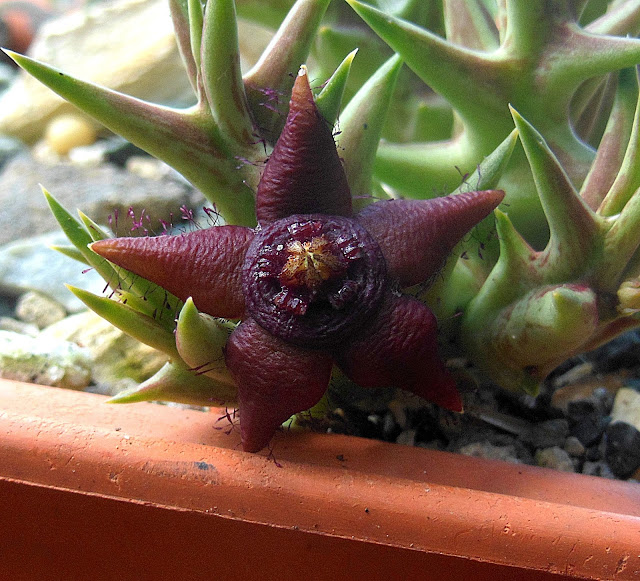Orbea semota subsp. orientalis and its lovely scent of poop
A native of Niger in the north, and Kenya and Tanzania in Central Africa, Orbea semota subsp. orientalis is distinguished from the nominate subspecies, O. semota subsp. semota, by its smaller flowers that are unadorned with blotches. The corolla lobes are rugose (with a roughened texture) and edged with clavate (club-shaped, or with the tips thickened) vibratile trichomes that move in a creepy way even at the slightest breeze. These trichomes are relatively longer than those from subsp. semota, but fewer in number. The annulus (that lifeguard-shaped structure at the center of the flower) as well as the corona are moistened. Dare I say that if touched, its lovely scent of feces will stick to your intruding finger. I repeat: feces. In a public toilet, to be more specific about it.
The flower is 2.5 cm across and unsurprisingly evolved to attract flies, its main pollinators. Even the color is insipid enough to recall the coloration of exposed and shriveling flesh of a dead animal festering under the tropical sun.

Ask not why I am keeping a horrid creature as this one, as there is something about the stapeliads (the group where this plant belongs) that endear themselves to more serious collectors. There is something about their form and otherworldliness that is seldom encountered in other plants. Rafflesia and Amorphophallus are downright bad asses, but cannot compare to the stapeliads' sheer diversity and form (the two genera have the upper hand on size, however).
The subspecific name refers to the eastern limit of the natural distribution of these plants, in Tanzania. The first plants to be scientifically collected were from the district of Taita, near Buru in southwestern Niger, further up on the northwest. Buru is the site of an Iron Age culture that was discovered in 1975 and still remains poorly understood. The nominate subspecies, subsp. semota, is also found on Kenya, but occur further southwards to Namibia.
The flower is 2.5 cm across and unsurprisingly evolved to attract flies, its main pollinators. Even the color is insipid enough to recall the coloration of exposed and shriveling flesh of a dead animal festering under the tropical sun.

This is the first flowering of this plant for me, which was given as an unrooted cutting by the latter half of November last year. A few buds are already in development at this stage. Like most of my succulents, this is potted in a mineral mix and given exposure to sun. Lots of it. Watering is carried out at least twice a week.
Ask not why I am keeping a horrid creature as this one, as there is something about the stapeliads (the group where this plant belongs) that endear themselves to more serious collectors. There is something about their form and otherworldliness that is seldom encountered in other plants. Rafflesia and Amorphophallus are downright bad asses, but cannot compare to the stapeliads' sheer diversity and form (the two genera have the upper hand on size, however).
The subspecific name refers to the eastern limit of the natural distribution of these plants, in Tanzania. The first plants to be scientifically collected were from the district of Taita, near Buru in southwestern Niger, further up on the northwest. Buru is the site of an Iron Age culture that was discovered in 1975 and still remains poorly understood. The nominate subspecies, subsp. semota, is also found on Kenya, but occur further southwards to Namibia.




Comments
Post a Comment